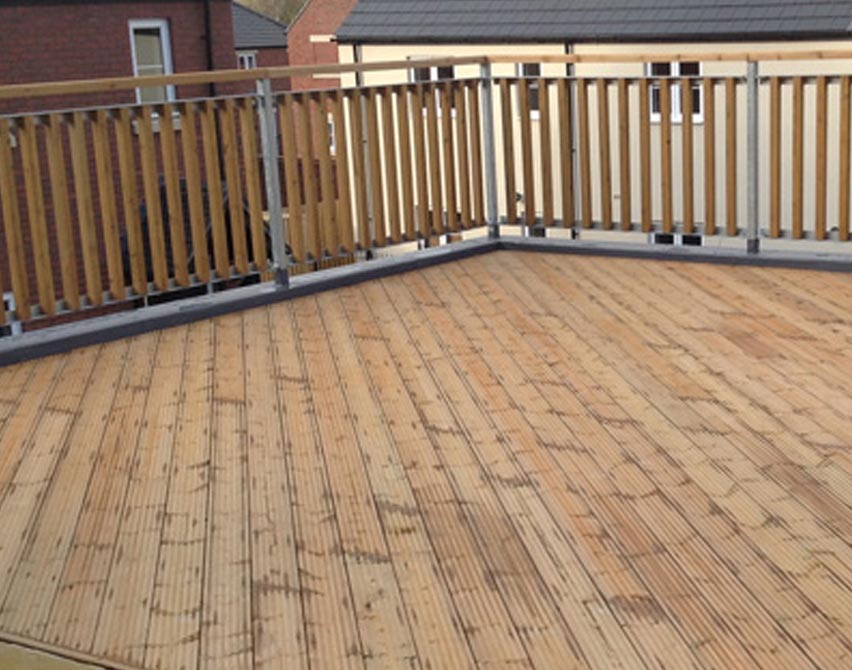The Ultimate Guide to Timber Decking Balustrades
Decking is a great way to enhance the value of your property by adding an outdoor social space. Be it a commercial property or a private one, decks have the power to transform sites into attractive and welcoming environments. Planning and constructing a quality deck can be a significant undertaking, especially for large, commercial properties, with perhaps no feature more important than its balustrade. From safety to durability and costs to aesthetics, there are many factors to consider- which is why today our team have put together a comprehensive overview for you.
Planning & Legal Requirements
In the United Kingdom, the regulations and standards that govern building work are set by Parliament and enforced by local authorities. All commercial decking in the U.K. requires consent from the local council, whereas private properties are covered by “permitted development rights”. However, although private decking may not require permission, they must still comply with U.K. building regulations. Commercial and private decks alike can be issued with an Enforcement Notice if the local council finds them to be in breach of regulations- which can result in the decking being modified or dismantled entirely. To ensure that you don’t run afoul of these regulations, consult your local council planning department.
There are many factors to consider when building a deck- as with any construction work- which is why these standards and regulations exist. Important considerations include:
- Protection from falling (especially where raised decks are concerned)
- Handicap access (does your deck require a ramp?)
- The strength of the deck (how much weight can it take?)
- Fire safety (are the appropriate materials being used?)
- Baluster spacing (in the U.K., it is a requirement that spindles or balusters not be more than 100mm apart)
Finding the Right Style of Balustrade for You
Your choice of balustrade will likely be governed by three factors: cost, safety, and aesthetics. Each style comes with its own pros and cons, and in this section we will examine them through the lens of these three factors. It should also be noted that the following balustrade styles can also be used in conjunction with each other to some extent. Popular combinations include metal spindles with glass panels, timber railing with glass panels, and timber railing with metal spindles.
- Timber
The most popular material for decking balustrades, timber comes in a wide range of forms and prices. Softwoods (such as pine, hemlock, spruce, redwood, larch, cedar, etc) grow much quicker, and are therefore cheaper and more environmentally friendly. Hardwoods (such as oak, ipe, teak, sapele, etc) grow slower as well as growing in fewer locations, making them less affordable. They are, however, much more durable than softwoods. For example, teak is particularly resistant to rotting and insect incursion due to its high oil content. As with every option on this list, what style you go for will depend on your specific needs; if you are looking to reduce costs or paint your balustrade, then a softwood like cedar might be your best choice. If you want a balustrade with a rustic aesthetic that emphasis the wood’s natural tones, or simply one better equipped to withstand moisture, then a sturdy hardwood such as oak would be better suited to your project. Either way, timber decking will require annual treatment with wood preservative. Timber is the material of choice for those that a balustrade with a natural, rustic aesthetic- ideal for countryside lodges and cabins. - Metal
Metal also comes in a range of forms and prices, but is generally more expensive than timber. Metal balustrades are strong and durable, requiring little maintenance. They will, however, start to rust if left untreated (with the exception of aluminium, which resists corrosion). There are several ways to prevent this, depending on the metal being used, such as galvanising for steel and powder coating for wrought iron. Metals are highly versatile materials, able to be coated in a variety of colours and malleable enough to be curved into a range of shapes. Metal balustrades are perfect for contemporary or industrial aesthetics; ideal for large, commercial sites but versatile enough to be incorporated into any design. - Glass
Whereas timber balustrades give decks a rustic appearance, glass balustrades provide a slick, modern aesthetic. Glass facilitates more light into a deck, as well as providing the illusion of more space. Unlike timber, glass requires little to no maintenance, requiring only to be washed occasionally with an appropriate detergent. Perfect for commercial sites going for a contemporary look, glass can also suit residential properties that want more light and vision on their gardens. - Composite
Composite materials, in the context of decking, are a timber alternative made from wood fibres and plastic. Composite decks and balustrades are much more durable than their timber counterparts, requiring little to no maintenance as they do not rot and are highly resistant to scratches and stains. They can also be produced in a range of colours- making them ideal for bespoke projects. They are, however, much more expensive than timber materials. Composite balustrades can suit a variety of properties, and are prized for their high quality and stylistic flexibility.
See more: Best Timber Species for Decking | NORclad (timbercladdingsolutions.co.uk)
Quality Timber Cladding with NORclad
At NORclad, we have over 40 years of experience as a leading manufacturing supplier of quality timber cladding. With excellent environmental credentials, all our materials are sustainably sourced and quality tested to the highest certified level. Experienced in providing bespoke project solutions for every type of property, our clients range from schools to supermarkets and office buildings to hotels.
For more information on our diverse range of timber cladding products, don’t hesitate to get in touch with our friendly staff today.


















